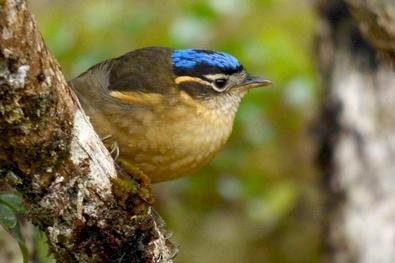Ifritidae – Blue-capped Ifrit

This one species has recently been assigned its own family; the Ifritidar. The blue-capped ifrit (Ifrita kowaldi), also known as the blue-capped ifrita, is a small insectivorous bird endemic to the rainforests of New Guinea. It measures up to 16.5 cm long and has yellowish brown plumage with a blue and black crown. The male has a white streak behind its eye, while the female’s is a dull yellow. It creeps on trunks and branches in search of insects.
It is placed as the only member of the genus Ifrita, which historically has been placed in the family Cinclosomatidae or the Monarchidae. It now appears the bird is more properly placed in its own family Ifritidae. This enigmatic bird is one of only three bird genera known to have poisonous members, the others being the genus Pitohui, also from New Guinea, and the little shrikethrush (Colluricincla).
The blue-capped ifrit, like the hooded pitohui, sequesters batrachotoxin in its skin and feathers, which causes numbness and tingling to those who handle the bird. The toxin is acquired from part of its diet, specifically Choresine spp. beetles.
Widespread and common throughout its large range, the blue-capped ifrit is evaluated as least concern on the IUCN Red List of Threatened Species.
The one species is:
Blue-capped Ifrit Ifrita kowaldi
-
Blue-capped Ifrit Ifrita kowaldi
IUCN Species StatusThe global population size has not been quantified, but the species is reported to be generally fairly common though thinly distributed in many places (Coates 1990). -
Blue-capped Ifrit Ifrita kowaldi
Species AccountSound archive and distribution map. -
Blue-capped Ifrit Ifrita kowaldi
Species AccountThe blue-capped ifrit (Ifrita kowaldi), also known as the blue-capped ifrita, is a small insectivorous bird endemic to the rainforests of New Guinea. It measures up to 16.5 cm long and has yellowish brown plumage with a blue and black crown. The male has a white streak behind its eye, while the female's is a dull yellow. It creeps on trunks and branches in search of insects.
